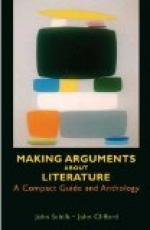For the use of this book when a comparatively short time, perhaps six weeks, is at the disposal of the instructor, my advice, based on the practice worked out with my colleagues in the freshman course at Harvard, would be to begin with Chapter I, and at the same time ask the class to hand in subjects for approval. This should be done a fortnight ahead of the main work, in order to allow changes of subject, after consultation if necessary. In connection with Chapter II would come exercises in making briefs of one or more of the arguments in the back of the book or of others provided for the purpose. Then would come the preliminary work on the brief, the introduction to the brief. This it is profitable to treat as a separate piece of work, with a grade of its own. At this stage would be the place for the exercises in the use of reference books, which will lead naturally to looking up the material for the brief. If possible a conference should be given on the introduction to the brief. Then comes the next main step in the work, the brief. The work for this would naturally be accompanied by study of Chapter III, and by such exercises in the correction of bad briefing and in correction of fallacies as the instructor finds time for. There should be another conference on the brief, and it should be rewritten if necessary. Instructors who have been through the subject will know from sad experience that one rewriting and one conference may be only starters. Then comes the argument itself: this should be the climax, and not merely a perfunctory filling out of the brief. If it be at all possible, the argument should be rewritten after a conference, and the conference can hardly be too long. If the argument is fifteen hundred or two thousand words long, a half an hour will be found a short time to go over the whole with any thoroughness. No instructor in English needs to have it pointed out that conferences are his most efficient means of education.
FOOTNOTES:
[Footnote 1: See Lincoln’s speech at Galesburg and at Quincy, in the Lincoln-Douglas debates.]
[Footnote 2: O. W. Holmes, Jr., The Common Law, Boston, 1881, p. 35.]
[Footnote 3: For such changes of fashion in literature see Stevenson’s Gossip on Romance and A Humble Remonstrance in “Memories and Portraits,” and The Lantern Bearers in “Across the Plains.”]
[Footnote 4: From the speech on the Repeal of the Union with Ireland; quoted by W. T. Foster, Argumentation and Debating, Boston, 1908, p, 90.]
[Footnote 5: A. Sidgwick, The Application of Logic, London, 1910, pp. 40, 44.]
[Footnote 6: From the speech of Senator Depew, January 24, 1911.]
[Footnote 7: C. R. Woodruff, City Government by Commission, New York, 1911, p. 11.]
[Footnote 8: A. Sidgwick, The Application of Logic, London, 1910, p. 248.]
[Footnote 9: W. Bagchot, The Metaphysical Basis of Toleration, “Works,” Hartford, Connecticut, 1889, Vol. II, p. 339.]




